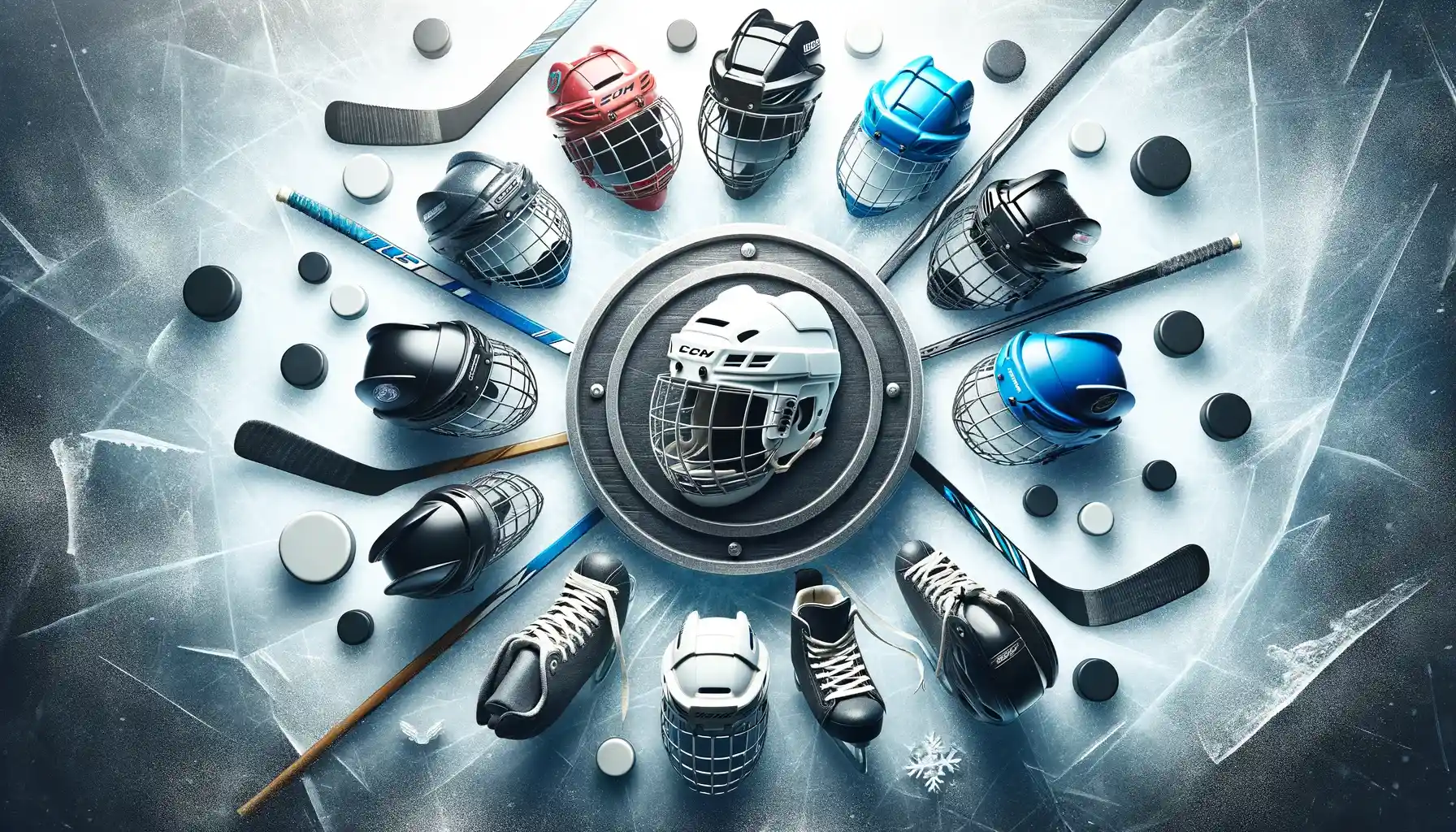In the exhilarating world of ice hockey, the significance of wearing a properly fitted hockey helmet cannot be overstated. A helmet that fits perfectly is crucial for maximizing safety, comfort, and performance on the ice. With renowned brands like Bauer and CCM leading the charge, understanding the nuances of helmet sizing becomes essential for every player, from the enthusiastic beginner to the seasoned professional.
This comprehensive guide will take you through the essentials of hockey helmet sizing, including how to accurately measure your head, interpret sizing charts, and consider brand-specific sizes. Let’s ensure your helmet is as ready for the game as you are.
Understanding the Basics of Hockey Helmet Sizing
The Role of Hockey Helmets in Player Safety
Hockey helmets are designed to offer protection against impacts, falls, and collisions, common occurrences in the fast-paced game of ice hockey. They are a critical piece of protective gear, helping to prevent head injuries and concussions. But for a helmet to offer optimum protection, its fit must be precise—too loose, and it may not provide adequate safety; too tight, and it could be uncomfortable, distracting from the game.
Why Helmet Sizing Matters?
The right fit ensures that the helmet effectively absorbs impacts, distributes force, and stays in place during the game’s rigorous movements. This is why understanding helmet sizing, from the basics of measuring circumference to the specifics of helmet types and brands, is pivotal.
How to Measure for a Hockey Helmet?
Step-by-Step Measurement Guide:
Finding the perfect helmet size starts with measuring your head. Here’s how you can do it:
- Measuring Circumference: Using a soft measuring tape, wrap it around your head, approximately one inch above your eyebrows, which is generally the widest part of your head. This measurement, in inches or centimeters, correlates directly to helmet sizes.
- Accounting for Hair and Growth: Consider the volume of your hair and, for younger players, the potential for growth. Hair can affect how the helmet fits, and selecting a size that allows for some growth can be a smart choice for children.
These measurements are the foundation for selecting the right helmet size, ensuring the helmet fits securely and comfortably.
Key Factors in Choosing the Right Hockey Helmet
Fit, Ventilation, and Weight Considerations:
Once you have your measurements, the next step is to consider other factors that influence the overall fit and feel of the helmet:
- Fit: A helmet should fit snugly without being uncomfortably tight. It should cover the head adequately without any gaps and not shift when you move.
- Ventilation: Adequate ventilation is essential for comfort and can affect your performance on the ice. Look for helmets that offer good airflow to keep you cool during the game.
- Weight: A lighter helmet can reduce neck strain and fatigue, making it easier to maintain focus and agility. However, it should not compromise on safety and protection.
Hockey Helmet Size Charts and Sizing Guides
Understanding the basics of helmet sizing is pivotal. A general hockey helmet size chart helps as a preliminary guide, but keep in mind the importance of brand-specific nuances.
Hockey Helmet Size Chart:
| Helmet Size | Age Range | Hat Size | Circumference (in.) | Circumference (cm.) |
|---|---|---|---|---|
| X-Small | 4 - 6 | 6 1/8 - 6 3/4 | 19.3" - 21.4" | 49 - 54.5 |
| Small | 7 - 11 | 6 1/2 - 7 | 20.6" - 22.2" | 52.3 - 56.4 |
| Medium | 12 - 16 | 6 7/8 - 7 3/8 | 21.9" - 23.3" | 55.6 - 59.2 |
| Large | 17+ | 7 3/8 - 7 3/4 | 22.7" - 24.5" | 57.7 - 62.2 |
| X-Large | 17+ | 7 5/8 - 8 1/8 | 24" - 26" | 61 - 66 |
This table serves as a foundational reference, but personal fit may vary. Always consider trying helmets on for the most accurate assessment.
Brand-Specific Sizing Charts and How They Differ
Differences in sizing charts across Bauer, CCM, and Warrior underscore the importance of understanding each brand’s approach to helmet sizing. Below are the updated sizing charts incorporating the provided data:
1. Bauer Helmet Sizing Chart
| Size | Circumference (in.) | Circumference (cm.) |
|---|---|---|
| Small | 20.3" - 21.9" | 51 - 55.5 |
| Medium | 21.5" - 23.4" | 54.5 - 59 |
| Large | 22.6" - 24.4" | 57.5 - 62 |
2. CCM Helmet Sizing Chart
| Size | Hat Size | Circumference (cm.) | Circumference (in.) |
|---|---|---|---|
| X-Small (Junior) | 6 - 6 5/8 | 48 - 53 | 18.9 - 20.87 |
| Small | 6 1/4 - 7 | 50.5 - 56 | 19.88 - 22.05 |
| Medium | 6 3/4 - 7 3/8 | 54.5 - 59 | 21.46 - 23.23 |
| Large | 7 1/4- 7 3/4 | 57.5 - 62 | 22.64 - 24.41 |
3. Warrior Helmet Sizing Chart
| Size | Hat Size | Circumference (cm.) | Circumference (in.) |
|---|---|---|---|
| Small | 6 5/8 - 7 | 54 - 56 | 21.26 - 22.05 |
| Medium | 7 - 7 3/8 | 56 - 59 | 22.05 - 23.23 |
| Large | 7 3/8 - 7 3/4 | 59 - 62 | 23.23 - 24.41 |
Understanding Variations Within Brands
Both Bauer and CCM, alongside other brands, tailor their helmets not just to different head sizes but also to the varying needs of players at different levels—from youth to professional. These variations can include differences in padding, adjustability, ventilation, and technology aimed at concussion prevention.
The key to finding your perfect fit lies in understanding these nuances. Utilizing the size charts provided by brands, combined with trying on multiple models, ensures you select a helmet that not only fits well but also provides the level of protection and comfort necessary for your style of play.
Once you’ve familiarized yourself with the sizing charts for Bauer, CCM, and Warrior, it’s beneficial to explore some of the top models each hockey brand offers. Understanding the unique features and benefits of these leading helmets can further inform your decision, ensuring you choose a helmet that not only fits well but also meets your specific playing needs and preferences.
Top Hockey Helmets from Leading Brands
Selecting the right hockey helmet is about more than just size; it’s about finding a helmet that offers the best in protection, comfort, and technology, tailored to your style of play. Here’s a look at some of the top models from industry leaders, designed to cater to a range of needs from recreational play to professional competition:
| Brand | Model | Features | Size Options | Ideal For |
|---|---|---|---|---|
| CCM | Tacks | Advanced protection, D3O smart material, customizable fit | S, M, L, XL (Junior to Adult) | Players seeking superior protection |
| Bauer | Hyperlite | Lightweight, PORON XRD foam, tool-free adjustment | S, M, L | High-performance athletes |
| Bauer | Re-Akt | VTX technology, enhanced ventilation, occipital lock | S, M, L | Players prioritizing comfort and safety |
| Warrior | Alpha One | True one-piece shell, superior fit and comfort | S, M, L | All-around players looking for balance |
| Warrior | Covert PX+ | Tailored balance, enhanced protection, adjustable fit | S, M, L | Dynamic players needing flexibility |
| Warrior | Alpha One Pro | Pro-level protection, lightweight, hydrophobic liner | S, M, L | Elite players needing top-tier safety |
How Should a Hockey Helmet Fit?
Finding the Perfect Fit
A well-fitting hockey helmet is paramount for player safety and comfort on the ice. The guidelines below are designed to help you ensure your helmet fits correctly, providing optimal protection during play.
Fit Guidelines:
- Tightness: The helmet should fit snugly around your head without causing discomfort. There should be no excessive movement; the helmet should stay in place when you shake your head.
- No Pressure Points: Ensure there are no pressure points around your head, especially at the temples or forehead. A helmet that’s too tight can cause headaches or discomfort, detracting from your focus and performance.
- Coverage: The helmet should cover the majority of your head, with the front edge resting about a finger’s width above your eyebrows. This ensures maximum protection against impacts.
Chin Strap and Mask Fitting:
- Chin Strap: The chin strap should be adjusted so that it’s tight enough to prevent the helmet from moving but not so tight that it’s uncomfortable. Ideally, you should be able to fit one finger between the strap and your chin.
- Mask Fitting: For helmets with attached face masks or shields, make sure the mask does not obstruct your vision and fits comfortably against your face. There should be no significant gap between the edge of the helmet and the mask to prevent sticks or pucks from making direct contact with your head or face.
Goalie Helmet Sizing and Considerations
Understanding Goalie Helmets
Goalie helmets, also known as goalie masks, are designed specifically for the unique needs and safety requirements of goaltenders. These helmets come with additional protective elements to shield against the high-impact shots goalies face.
Sizing and Protective Elements:
- Sizing: Like player helmets, goalie helmet sizing is crucial for effective protection. Measure your head circumference to start, and consult brand-specific sizing charts for goalie helmets, as they can differ from standard hockey helmet sizes.
- Additional Protective Elements: Goalie helmets often feature reinforced forehead and chin areas, thicker padding, and a more substantial cage designed to withstand direct puck hits. These elements are critical for preventing concussions and facial injuries.
Considerations:
- Vision: Ensure the helmet allows for a wide field of view. Goalies need to track the puck from all angles, making unrestricted vision a top priority.
- Comfort and Ventilation: Given the stationary nature of the goaltending position, it’s essential that the helmet provides adequate ventilation to keep you cool and comfortable throughout the game.
- Customization: Many goalies opt for customized masks that provide a personalized fit and aesthetic. Consider this option if you’re looking for the utmost in comfort and style.
Frequently Asked Questions on Hockey Helmet Sizes
Can you make a hockey helmet wider?
Most modern helmets come with adjustable features to slightly alter the width and fit, but there’s a limit to how much adjustment is possible.
How long do hockey helmets last?
Hockey helmets should be replaced every 5 to 7 years, sooner if they show signs of damage or after significant impacts.
Should your helmet be tight?
Yes, but not uncomfortably so. It should be snug enough to stay in place during play.
What are the safest youth hockey helmets?
Look for helmets with certifications (e.g., CSA, HECC) and those that fit well. Models with the latest safety features and materials are often the safest.
How do I know my hockey helmet size?
Measure the circumference of your head just above your eyebrows and consult the helmet’s sizing chart.
How tight should a hockey helmet fit?
It should be snug enough that it doesn’t move when you shake your head but not so tight that it causes pressure points.
How to fit a Bauer hockey helmet?
Bauer helmets often come with an adjustment system. Begin with your head measurement, adjust the helmet for snugness, and ensure there are no pressure points.
What size is a 24-inch helmet?
A 24-inch (approximately 61 cm) head circumference typically falls into the “Large” size category for most adult helmets.
Final Thoughts
Ensuring your hockey helmet fits correctly is vital for both safety and comfort on the ice. A well-fitted helmet can significantly reduce the risk of head injuries. Whether you’re a player or a goalie, take the time to measure your head accurately, try on different brands and models, and adjust the fit as needed.
If you’re uncertain, don’t hesitate to seek advice from professionals at sporting goods stores or consult with your team’s equipment manager. The right helmet not only protects you but also allows you to focus on enjoying the game.
To further enhance your knowledge and ensure you’re fully equipped for the game, consider exploring these additional resources:
- Comprehensive Guide on Buying Hockey Skates – Learn how to select the best skates that complement your helmet for optimal safety and performance.
- Top Hockey Skate Brands – Discover which brands offer the best quality and value in hockey skates.
- Choosing the Right Hockey Skate Hollow – Understand the importance of skate blade hollows and their impact on your skating ability.
- How to Sharpen Hockey Skates – Master the essential skill of skate sharpening to maintain peak performance on the ice.
- Hockey Taping Techniques – Learn the best practices for taping your hockey stick and other equipment.
- Understanding the Hockey Jersey Fight Strap – Get insights into this unique feature of hockey jerseys and its role in the game.
- Comprehensive Guide to Ice Hockey Equipment – A detailed look at all the equipment you need to play hockey safely and effectively.




